DIY Pet Bird Bath: Build a Safe and Fun Space
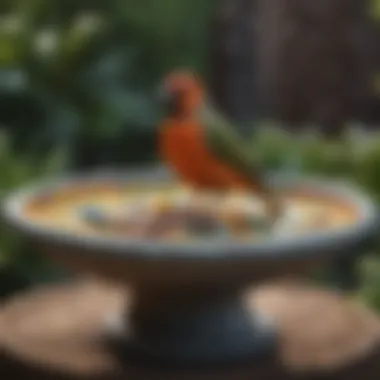
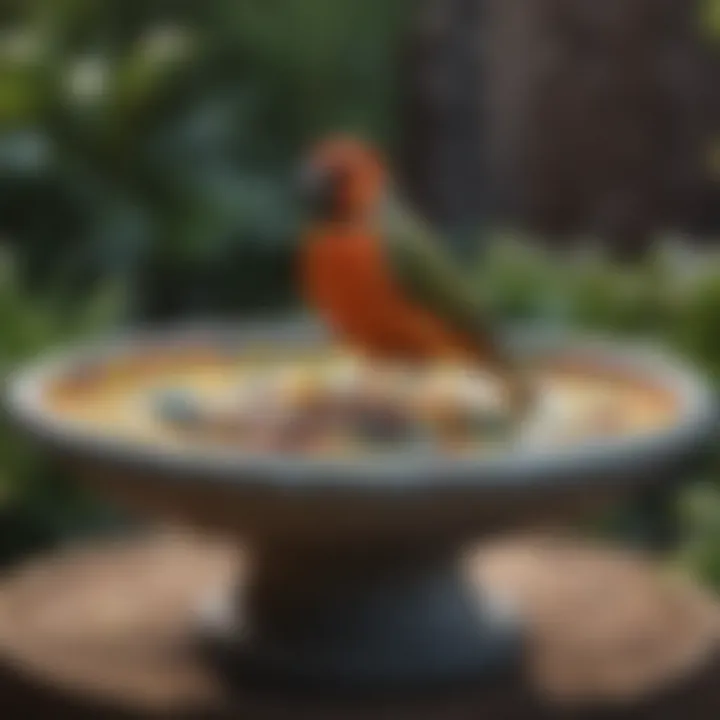
Intro
Creating a do-it-yourself bath for pet birds is not only a rewarding project but also an important aspect of avian care. A bird bath can enhance the well-being of your feathered companions by providing them with a clean and enjoyable space for bathing. This guide aims to present practical information and insights into constructing a suitable bathing area that meets the specific needs of different bird species.
Bathing is essential for birds as it helps them maintain their feathers in optimal condition. Proper feather care ensures insulation, protection against parasites, and overall health. Thus, understanding how to effectively create a bird bath is crucial for any pet bird owner.
In this article, we will explore various materials, designs, and placement strategies. We will also discuss key considerations for hygiene and safety, helping you make informed decisions throughout the process.
Care Tips
Creating a bathing environment involves not just the bath itself, but also understanding the overall care that your pet bird needs. Consider the following aspects of bird care:
Daily Care Routines
Daily routines should include monitoring your bird's interest in the bath. Some birds love to splash around, while others might need encouragement to bathe. Observe their behavior and adjust routines accordingly.
Cage Setup and Maintenance
Ensure that the cage is positioned near the bird bath. This association helps the bird see the bath as a part of its living environment. Regularly check that the cage is clean with no droppings or leftover food. A clean environment encourages healthy behavior.
Hygiene and Cleaning Practices
Keeping the bird bath clean is essential. Use warm water to rinse the bath daily and replace the water. Avoid using harsh chemicals; instead, simple dish soap can suffice. Weekly, perform a more thorough cleaning by scrubbing with a soft brush.
Seasonal Care Adjustments
Birds may have different bathing needs depending on the season. During warmer months, they may enjoy more frequent baths. In contrast, during colder months, limit bathing to avoid chilling. Adjust water temperature based on season and ensure it is comfortable for the birds.
Behavioral Insights
Understanding your bird’s behavior can enhance the bathing experience.
Understanding Bird Body Language
Birds communicate through body language. Signs such as fluffing feathers or a relaxed stance may indicate a happy bird ready to bathe. Pay attention to such cues during bath time.
Common Behavioral Issues and Solutions
If a bird shows aversion to bathing, try a shallow dish or misting with lukewarm water. Gradually introduce them to the bath experience while ensuring a stress-free environment.
Positive Reinforcement Techniques
Use treats to encourage bathing. Rewarding your bird when it enters the bath can create a positive association.
Social Interaction Needs
Some birds enjoy bathing in groups. If you have multiple pet birds, observe if they prefer to bathe together. Group bathing can promote social behaviors and bonding.
Nutrition Guides
While not directly related to baths, nutrition affects skin health and feather quality.
Essential Diet Components
A balanced diet for pet birds should include seeds, pellets, fruits, and vegetables. Ensure access to fresh food to support their health.
Safe and Toxic Foods
Know which foods are safe. For example, vegetables like spinach and carrots are generally fine. In contrast, avoid avocados, chocolate, and caffeine, as they are toxic.
Supplements and Treats
Consider avian supplements if necessary. These can provide nutrients that help with feather quality.
Feeding Strategies for Different Species
Different bird species have unique dietary requirements. Research your bird's specific needs to create a suitable feeding plan.
Wellness and Health
Bird baths are part of overall wellness. Regular health checks play a critical role.
Routine Health Checkups
Schedule routine vet visits to monitor your bird's health. Be aware of their weight and behavioral changes.
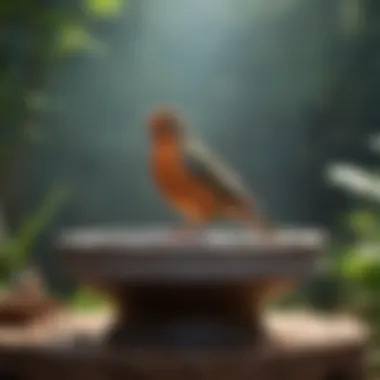
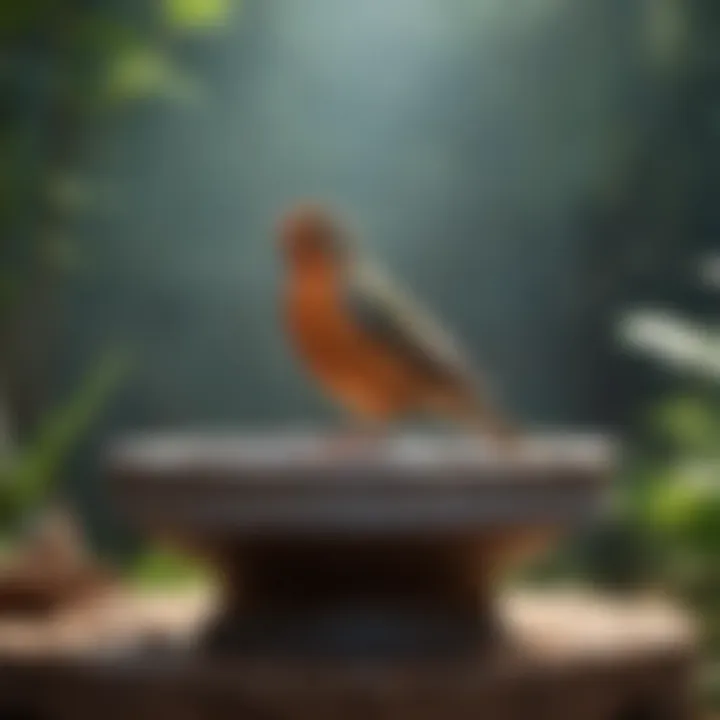
Identifying Symptoms of Illness
Learn common signs of illness like lethargy or feather loss. Early detection can lead to better outcomes.
Preventative Care and Vaccinations
Preventative care, including necessary vaccinations, aids in keeping your bird healthy.
Mental and Emotional Well-being
Provide toys and interaction to ensure mental stimulation alongside physical care.
Enriching Activities
Creating diverse activities is also essential for pet birds.
Toys and Playtime Ideas
Birds enjoy various toys such as bells, mirrors, and ropes. Rotate toys regularly for sustained interest.
Training and Tricks
Engage your bird in training sessions. Simple tricks can stimulate their mind and reinforce bonding.
Outdoor Activities and Interaction
Consider supervised outdoor time. Natural sunlight and fresh air can contribute to their overall well-being.
DIY Projects for Mental Stimulation
Alongside the bird bath, consider additional DIY projects. Crafting perches or toys can enhance their living space further.
By investing time and effort into creating a suitable bathing environment, you not only improve your bird’s hygiene but also enrich their life with activities that encourage natural behaviors.
Overall, by focusing on these essential aspects, you can create an enriching and healthy environment for your pet birds, ensuring they thrive in your care.
Foreword to Pet Bird Baths
Establishing a suitable bathing area for pet birds is critical for their overall health and well-being. Birds naturally engage in bathing behaviors, which help them maintain plumage hygiene, regulate body temperature, and promote skin health. In a domestic setting, owners must provide opportunities for their avian companions to partake in regular baths. The DIY pet bird bath not only fulfills this necessity but also allows owners to tailor the bathing experience to their specific bird species, needs, and preferences.
Importance of Bathing for Birds
Bathing plays a fundamental role in the health of birds. It helps cleanse feathers of dirt, dust, and parasites. The act of bathing also aids in the distribution of natural oils secreted from their skin, resulting in shiny and well-maintained feathers. Furthermore, many birds enjoy water and engage in social behaviors during bath time, which can enhance their mood and overall mental health.
Regular bathing can reduce stress levels. For example, when birds have a chance to bathe, they exhibit less feather plucking and other destructive behaviors. It is important to note that different species have varied bathing needs. For instance, some birds prefer shallow water while others may relish deeper baths.
Overview of DIY Options
Creating a DIY bird bath allows pet owners to customize the structure to fit the specific requirements of their birds. An array of options is available for DIY enthusiasts, ranging from simple containers to intricately designed setups. The choice largely depends on the available space, budget, and the birds' unique behaviors.
Possible approaches include:
- Using household items, such as shallow trays or large bowls. These can be excellent starting points for birds that do not require elaborate bathing environments.
- Building elevated baths with a stable base. This method offers higher visibility for the birds and encourages them to explore their bathing area comfortably.
- Incorporating natural materials, such as stones or grass, creates a more appealing environment for many birds. This style mimics natural habitats, promoting a sense of security and comfort.
"A well-thought-out DIY bath fosters a richer experience for your pet bird, making it more enjoyable and beneficial."
As we navigate further into the nuances of designing a DIY pet bird bath, it is essential to keep in mind not only the preferences of individual birds but also the significance of safe, practical designs that consider the well-being of your feathered friends.
Choosing the Right Materials
Choosing the right materials for a DIY bird bath is crucial to the success and safety of your project. The materials you use can significantly impact the durability, hygiene, and overall functionality of the bath. Proper selection ensures that the bath withstands weather changes, is safe for your birds, and remains easy to clean. Using high-quality, water-resistant materials can prevent leaks and damage, ultimately leading to a better bathing experience for your pets.
When creating a bird bath, consider the species of your pet birds. Different birds have varying bathing preferences. Some may prefer shallow water, while others might relish a deeper experience. Choosing the right materials also means considering the environment in which the bath will be placed, whether outdoors or indoors, as exposure to elements can influence material selection.
Water-Resistant Materials
Water-resistant materials are key to a successful bird bath. They prevent water from seeping into the bath’s structure, which helps maintain both integrity and hygiene. A few suitable options include:
- Plastic: Lightweight and easy to mold into different shapes, plastic is a common choice. Look for high-density polyethylene or a UV-stabilized variant for outdoor use.
- Ceramic: Offers great aesthetics and stability. Ensure that the ceramic is glazed to prevent water absorption.
- Metal: Options like stainless steel or aluminum are durable. They resist rust when treated properly. Make sure that the edges are smooth to prevent injury to the birds.
These materials not only handle water well but are also generally achievable for DIY enthusiasts. Use appropriate adhesives and sealants to ensure construction is watertight.
Safety Considerations
Safety should never be overlooked while building a bird bath. Your pet birds will interact directly with the bath. Thus, ensuring that the materials and design do not pose any risks is essential. Key points to consider include:
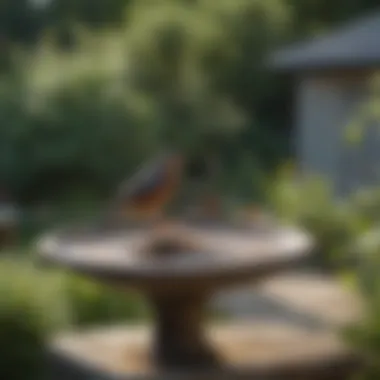
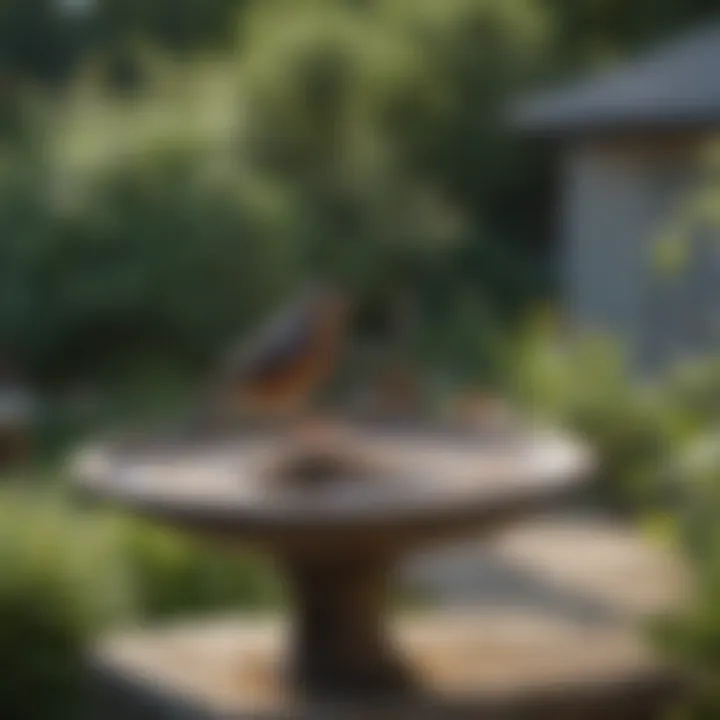
- Non-Toxic Materials: All products used must be free of harmful chemicals. Certain paints and finishes can be hazardous, so opt for non-toxic ones specified for bird-safe use.
- Smooth Edges: Birds can easily injure themselves on sharp edges. Ensure all cuts and joins are smoothed out before introducing the bath to the birds.
- Stability: The bath should be sturdy enough to prevent tipping over. A heavy base or proper anchoring is essential, especially if placed outdoors.
Remember: A safe bird bath is one of the most effective ways to promote your birds' physical well-being.
By choosing the right materials and considering safety effectively, you will create a bird bath that not only serves its purpose but also enhances the overall environment for your pet birds.
Designing the Bath
Designing the bath is crucial in ensuring that your pet bird feels comfortable and safe while bathing. The right design not only promotes hygiene but also enriches the bird's bathing experience. It entails knowing the specific requirements of your bird species, which can vary significantly. Ultimately, a well-designed bath will encourage regular use and provide an enjoyable experience for your avian companion.
Size Considerations
When creating a bird bath, size is a primary aspect to consider. The size of the bath should be proportionate to the bird’s own dimensions. Smaller birds such as finches or canaries require shallower basins, while larger species like parrots may need deeper and wider bathing areas. A bath that is too large can intimidate smaller birds, while a bath that is too small can restrict movement for larger birds.
Measure the size of your bird to determine the best bath dimensions. A bath that is easily accessible encourages frequent use.
Shape and Depth
The shape of the bird bath plays a significant role in its functionality. Birds tend to prefer irregular shapes that mimic natural water sources. Shallow areas allow birds to wade and splash, which is essential for their cleaning behavior. Depth also matters; a depth of about one to two inches is generally ideal for most small to medium-sized pet birds.
Consider design features like gentle slopes or textured surfaces to help birds feel secure while bathing.
Drainage Solutions
Adequate drainage is vital for maintaining hygiene in your bird bath. Standing water may lead to bacterial growth or algae formation, which is harmful to your pet. Build the bath with proper drainage systems in mind. Consider incorporating a slight slope at the basin's bottom towards a drain hole. If using a container, ensure it can be emptied easily after each use to keep the environment clean.
Remember, a clean bath is essential for your bird's health.
"Providing a well-designed bird bath encourages birds to engage in essential bathing behavior, which is vital for their health and wellness."
In summary, by thoughtfully considering size, shape, depth, and drainage in your bird bath design, you can create a safe and inviting environment that promotes your bird's wellbeing.
Placing the Bird Bath
Placing the bird bath correctly is essential for encouraging your pet birds to use it regularly. The bath's location can affect not only the bird's willingness to bathe but also their overall wellbeing. A thoughtful position allows birds to feel safe and comfortable while they enjoy their bath. Additionally, proper placement ensures that you can monitor their behavior during bathing times. In this section, we will discuss ideal locations and environmental considerations to enhance your bird bath experience, ensuring it is both functional and enjoyable for your feathered friends.
Ideal Locations
Finding the right location for your bird bath involves considering your birds’ natural behaviors and preferences. Here are some key factors to consider:
- Visibility: Choose a spot that allows birds to see around them easily. This way, they can spot potential threats and feel at ease while bathing.
- Accessibility: The bath should be within reach for most of your birds, but not in a place where it might easily tip over or become dirty quickly.
- Shelter: Placing the bath near shrubs or trees can provide a sense of safety. Birds often prefer environments that mimic their natural habitats, where they can retreat if they feel threatened.
- Sunlight: Some birds enjoy bathing in sunlight, while others may prefer shade to avoid overheating. Observe your birds to determine their preferences and adjust accordingly.
- Proximity to Other Resources: Place the bath near food and water sources. Birds are more likely to engage with the bath if it is located near where they typically gather.
Environmental Considerations
When selecting the placement of your bird bath, environmental factors also play a critical role in its success:
- Weather Conditions: Consider how your region's climate will impact the bath. In hot weather, an open area might be preferable, allowing birds to cool off quickly. In colder climates or seasons, shelter from wind and rain is essential.
- Wildlife: If you have pets or local wildlife, ensure they cannot easily access the bath. This protects both your birds and prevents stress that can come from feeling vulnerable.
- Cleaning Access: The placement should not only encourage bathing but also make it easy for you to clean. A bath too far from your usual routines might become neglected.
- Pests and Insects: Avoid placing the bath too close to stagnant water or dense vegetation where insects may breed. Mosquitoes and other pests can deter your pets from utilizing the bath and introduce health risks.
“Choosing the right location for your bird bath can significantly enhance your pet bird’s bathing experience and promote their overall health.”
By considering these factors for placement, you can create a bathing environment that is safe, enjoyable, and inviting for your birds.
Enhancing the Bathing Experience
Enhancing the bathing experience is crucial for ensuring that pet birds are comfortable and happy during their bath time. Birds can be sensitive creatures, and providing them with an enriching environment can promote positive behavior and well-being. By being mindful of how to enhance this experience, pet owners can create a space that not only meets the basic needs of hygiene but also stimulates the natural instincts of their avian companions. Key elements to consider include the incorporation of natural elements and the use of safe additives that contribute to a more enjoyable bath.
Incorporating Natural Elements
Using natural elements in the bird bath can make the experience more appealing to our feathered friends. Birds in the wild often bathe in natural settings, surrounded by plants and water features. Here are several ways to integrate natural elements:
- Plants: Adding small, non-toxic plants around the bath can give birds a sense of security. Ferns and small shrubs can mimic their natural environment.
- Stones and Pebbles: Including flat stones or smooth pebbles in the bath adds texture. Birds can perch on them, making it easier for them to splash and play.
- Branches: A few sturdy branches can provide a place for birds to rest and preen after bathing. It also encourages them to engage with their surroundings.
- Water Movement: Gently circulating the water can mimic a stream. This not only keeps the water fresh but also attracts birds, encouraging them to bathe.
These elements can make bath time more engaging. They can help replicate a natural habitat, fostering instincts birds naturally possess.
Using Safe Additives
When considering bath additives, it is essential to prioritize safety. Some products can be harmful to birds. Here are some safe options that can enhance the bathing experience:
- Herbal Infusions: Adding herbal infusions like chamomile can have calming effects. Ensure that any herbs used are safe for avian consumption.
- Baking Soda: This is a mild agent that can help keep water fresh and odor-free without harmful chemicals.
- Essential Oils: While essential oils should be used with caution, certain bird-safe oils can provide a pleasant scent. Use them sparingly and ensure they are non-toxic.
- Edible Flowers: Adding flowers like hibiscus can make bath time visually appealing and nutritious at the same time. Ensure the flowers were not treated with any pesticides.
By choosing safe additives, pet owners can enhance bath time while safeguarding their birds.
Remember: Always monitor your bird's reactions to new elements. Observing their preference contributes to better adjustments in the bathing experience.
Cleaning and Maintenance
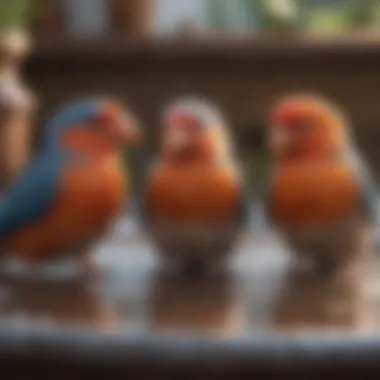
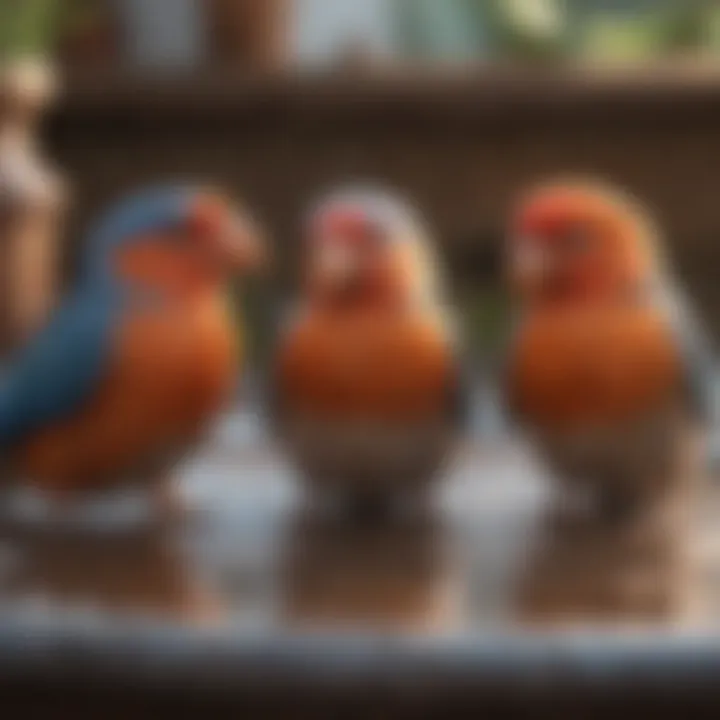
Regular cleaning and proper maintenance of your DIY bird bath are crucial for the health and happiness of your pet birds. Maintaining a clean bathing environment prevents the buildup of harmful bacteria and ensures that the water remains fresh and inviting. Birds are sensitive creatures, and their bathing habits can be greatly affected by the cleanliness of their bathing space. A dirty bath can lead to unease and even illness—factors that no owner wants for their feathery companion.
Key aspects to focus on include establishing a cleaning routine, understanding the specific needs of different bird species, and addressing common issues related to algae growth.
Routine Cleaning Practices
Establishing a routine for cleaning the bird bath is essential. Depending on how frequently your birds use the bath, you may need to clean it every few days. Here are some practices to incorporate:
- Daily Rinse: Each day, rinse the bath with clean water. This helps remove any droppings or debris that may accumulate.
- Weekly Deep Clean: Once a week, perform a more thorough cleaning. Remove the bath from its designated spot, and scrub it with a soft brush. Use a mild detergent that is safe for animals, followed by a good rinse.
- Avoid Harsh Chemicals: Strong chemicals can be harmful to birds. Stick to natural or bird-safe products when cleaning.
- Check for Wear: Regularly inspect the bird bath for signs of damage or wear. Cracks and chips can harbor bacteria.
"A clean bird bath is not just a luxury but a necessity for avian health."
These practices help maintain hygiene and encourage birds to bathe regularly. Birds often benefit from water that is both fresh and visually appealing.
Addressing Algae Growth
Algae growth is a common issue in bird baths, especially in warmer weather. If left unchecked, algae can create an unsightly appearance and may emit unpleasant odors. Here are steps to manage and prevent algae:
- Choose the Right Location: Place the bath in a shaded area to reduce sunlight exposure. Direct sunlight encourages algae growth.
- Increase Water Circulation: Consider using a small fountain or a bubbler. Moving water is less likely to become stagnant, which helps prevent algae buildup.
- Use Natural Solutions: For existing algae, a mixture of vinegar and water can be effective. After scrubbing away algae, make sure to rinse thoroughly.
- Monitor Water Levels: Ensure that the bath has sufficient water at all times. Low water levels can foster algae growth as it becomes more concentrated.
Regularly monitoring and addressing algae growth is as important as routine cleaning. A proactive approach helps provide a safe and inviting bathing space for birds.
Safety Precautions
When creating a DIY pet bird bath, safety precautions play a critical role in ensuring the well-being of your avian companions. Birds are delicate creatures, and their environments must be carefully controlled to prevent accidents and injuries. By prioritizing safety, you not only foster a healthy bathing experience but also mitigate the risk of potential dangers associated with water and unsuitable materials. This section will explore two primary areas of safety: supervision during bathing and the necessary first aid measures for emergencies.
Supervision During Bathing
Constant supervision is vital when your bird is using the bath. Water can pose risks, especially if a bird becomes too excited or agitated. Their small size makes them susceptible to drowning or slipping. Here are key considerations:
- Choose a Safe Location: Position the bird bath in an area where it is easily visible. This allows you to monitor your bird's behavior without obstruction.
- Stay Present: Always remain nearby when your bird is bathing. If a problem occurs, immediate assistance can be provided.
- Limit Bath Time: Birds typically enjoy bathing for a short duration. Limiting time in the bath reduces exhaustion and keeps their activity energetic.
By being vigilant, you can ensure your bird bath is a positive experience rather than a hazardous one.
First Aid Measures
Despite your best efforts at prevention, accidents can still happen. It is essential to be prepared with appropriate first aid measures tailored to the common issues birds may face around water. Familiarizing yourself with these responses can make a significant difference. Key first aid intentions include:
- Rescue from Drowning: If a bird appears to be struggling in the water, gently remove it as soon as possible. Make sure the bird is safe and dry. Warmth is crucial in these moments, so wrap it in a soft towel.
- Assess for Injuries: After rescuing, check for signs of injury or distress, such as difficulty breathing or visible wounds.
- Calm the Bird: Stress can escalate injuries. Keep the environment quiet and relaxed. This can include placing the bird in a calm space until it stabilizes.
- Consult a Veterinarian: If injuries are suspected or if the bird exhibits unusual behavior, a vet visit may be essential. Keeping details of your bird’s condition documented can help during consultation.
First aid preparedness can save a life. Always have the contact of an avian vet accessible.
Being proactive about safety is beneficial in caring for your pet bird. By implementing supervision and understanding first aid, you create a secure bathing experience that enhances your bird's hygiene and happiness.
Observing Your Bird's Behavior
Observing your bird's behavior can be crucial to creating a quality bathing experience. Birds communicate their preferences and emotions through behaviors. By paying careful attention, owners can tailor the bird bath to enhance the well-being of their pets. Understanding these cues not only enriches the bathing process but also promotes a trusting relationship between the bird and its owner.
Understanding Preferences
Each bird species has unique preferences when it comes to bathing. For instance, some birds prefer shallow water, while others enjoy deeper baths. Understanding what your bird likes helps inform the design of the bath. Observe your bird's reactions during bath time. Do they splash and play, or do they sit cautiously?
To gain insight into their preferences, consider the following aspects:
- Water temperature: Birds often enjoy luke-warm water, as it mimics a natural stream.
- Depth of water: Some birds feel safer in shallow water, while others may go for a deeper experience.
- Placement of bath: Birds might prefer baths in quiet, safe corners rather than in busy areas.
By monitoring these factors, you can create a more enjoyable and comfortable bathing space that aligns with your bird's natural instincts.
Identifying Stress Indicators
It's equally important to identify stress indicators in your bird during bath time. Signs of stress can include excessive flapping, vocalization, or attempting to flee. Understanding these signals can help prevent negative experiences that lead to anxiety. If your bird seems uncomfortable, take notice of their body language and make necessary adjustments.
Here are some common stress indicators to watch for:
- Puffed feathers: This can indicate discomfort or the need for space.
- Rapid breathing: An increased heart rate can signal distress or fear.
- Hiding: If your bird tries to escape or hide, it may feel threatened.
"Stress can manifest in various ways. Recognizing these signs early can help ensure your bird feels secure during bath time."
Addressing stress promptly can improve your bird's overall bathing experience. Adjust the bath's design, water temperature, or location as needed. Remember, a calm bird is more likely to enjoy bath time, making it a beneficial routine for both pet and owner.
Finale and Final Thoughts
The insights provided in this article offer a roadmap for pet bird owners who wish to create an engaging environment. By combining proper materials, thoughtful design, and strategic placement, it is possible to construct a bathing area that is both safe and enjoyable for birds. Additionally, regular cleaning and attention to safety precautions ensure that the bath remains a positive feature in your home.
Recap of Key Points
- Bathing is essential: Regular bathing contributes to the physical and mental health of birds.
- Material selection matters: Using water-resistant and safe materials enhances durability and safety.
- Size and design considerations: Tailoring size and depth to suit different bird species improves their bathing experience.
- Observation is key: Paying attention to bird behavior helps in adapting the bathing experience to better meet their needs.
- Ongoing maintenance is crucial: Routine cleaning prevents health issues related to stagnant water and algae growth.
Encouragement for DIY Projects
Embarking on DIY projects can be both fulfilling and practical. A custom bird bath allows pet owners to tailor functionality and aesthetic appeal according to their preferences. Not only does it promote creativity, but it also fosters a deeper connection between you and your birds.
Furthermore, the experience of constructing a bath can be educational. Engaging in this process allows for a better understanding of avian needs, which can improve caregiving skills overall. The satisfaction derived from seeing your birds interact with a home-made bath is an added benefit that goes beyond traditional ownership. Remember, the end goal is to create an enriching environment that your pets will thrive in.















